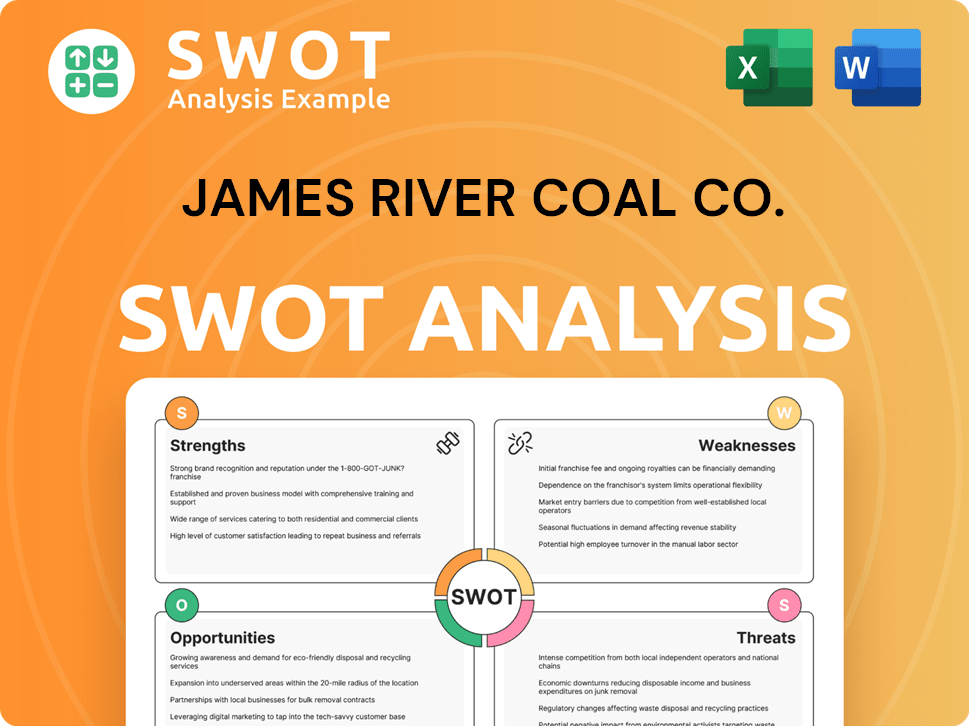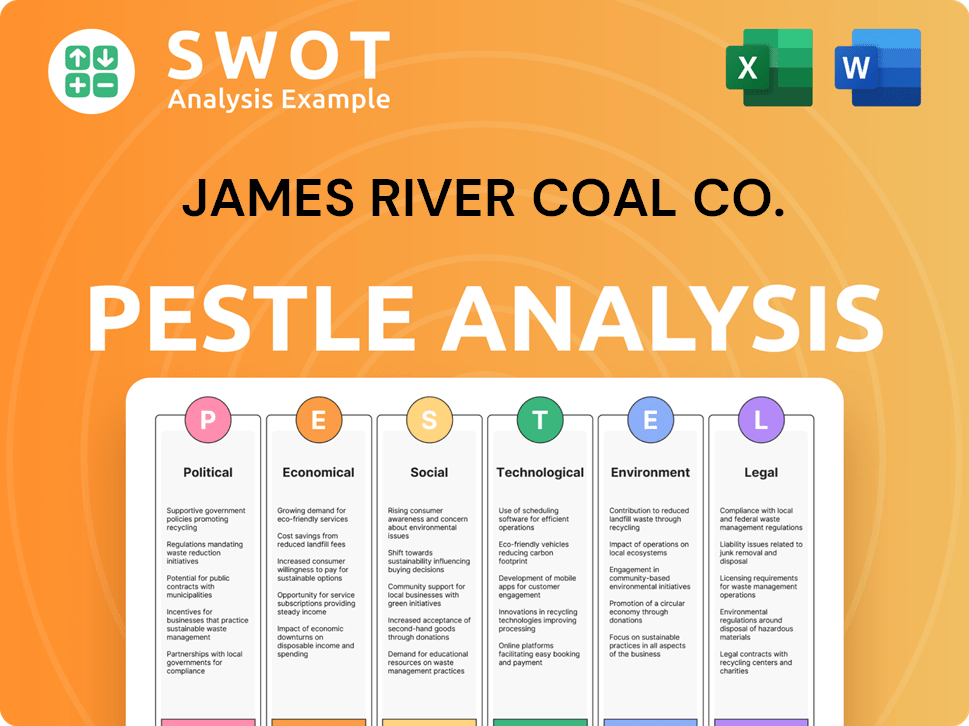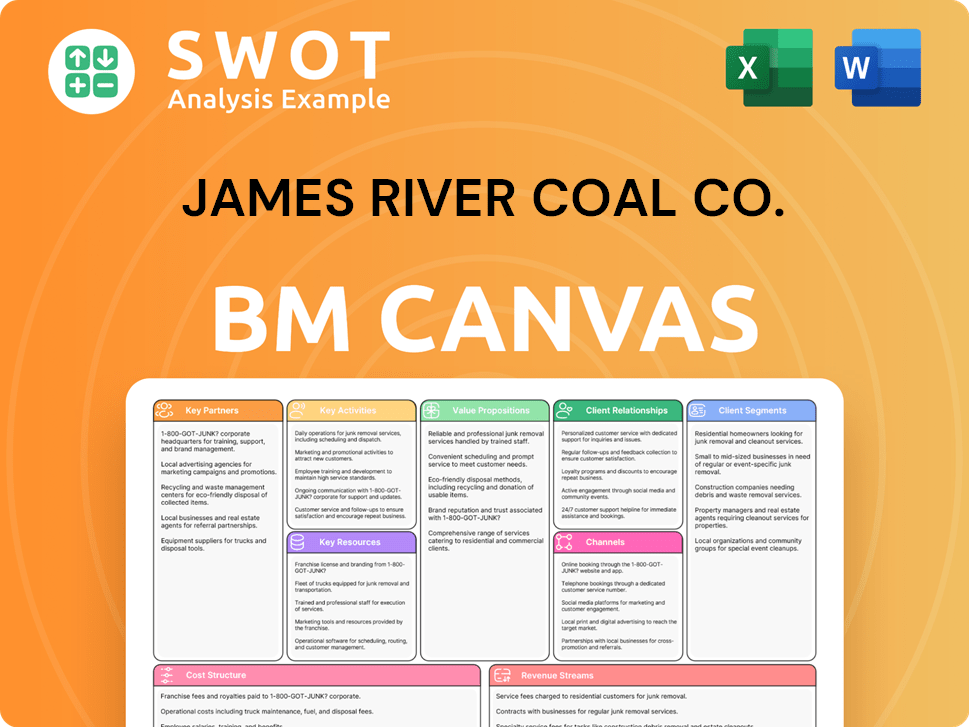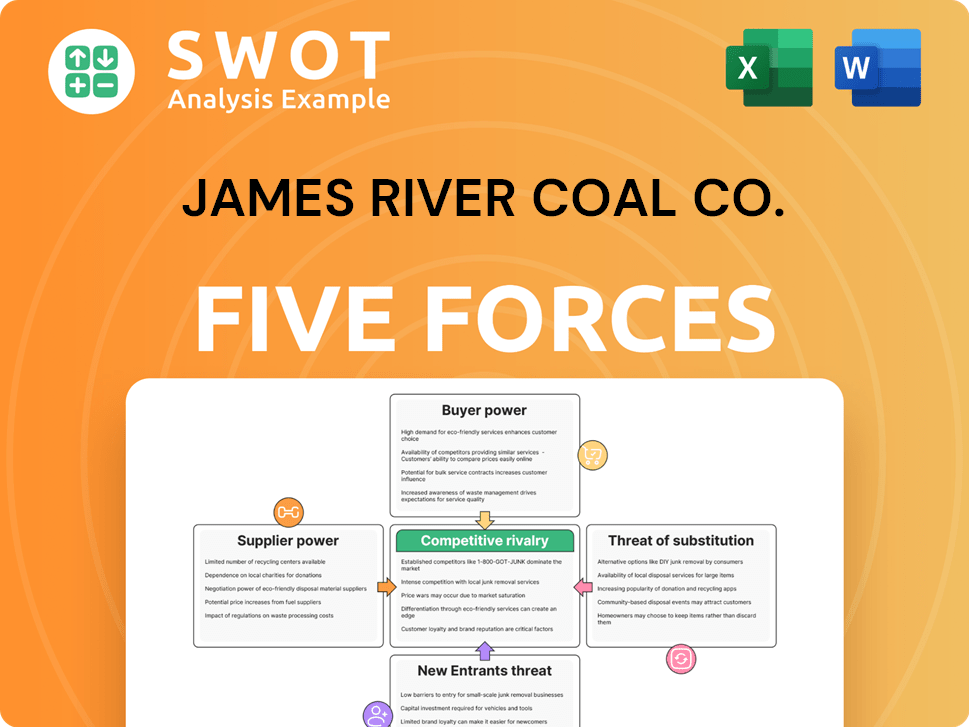James River Coal Co. Bundle
Can the Rise and Fall of James River Coal Company Teach Us About Growth?
Once a major player in the American coal industry, James River Coal Company's journey from expansion to bankruptcy offers a compelling case study in strategic planning. From its inception in 1991, the company aimed to capitalize on the demand for steam and metallurgical coal. But what factors led to its eventual downfall, and what lessons can be learned about navigating the volatile James River Coal Co. SWOT Analysis and the broader coal industry?

This analysis delves into the James River Coal Co. SWOT Analysis, examining its James River Coal Co. business model analysis, James River Coal Co. competitive landscape, and the impact of James River Coal Co. impact of regulations to understand its challenges and opportunities. Furthermore, we explore the James River Coal Co. market trends and strategic missteps that ultimately shaped its fate, providing valuable insights for investors and business strategists alike.
How Is James River Coal Co. Expanding Its Reach?
Given that the operations of James River Coal Company ceased in 2014 due to bankruptcy, there are no current or future expansion initiatives directly attributable to the company. The discussion on expansion, therefore, focuses on historical activities and strategic moves undertaken prior to its closure. This perspective is crucial for understanding the Growth strategy and Future prospects, even though the company is no longer operational.
Historically, the company aimed to grow its market presence and production capacity. Before its bankruptcy, the company had several expansion plans. These plans included acquisitions and diversification to capture more market share and increase its operational scope within the Coal industry. The primary focus was on increasing coal output and exploring new opportunities.
The company's historical actions provide insight into its strategic direction before its closure, offering a valuable case study for Company analysis and understanding past Market trends.
In March 2011, the company announced its intention to acquire International Resource Partners LP for $475 million. This acquisition was a strategic move to enhance its coal output and shipping capabilities. International Resource Partners' mines produced 1.9 million tons of coal in 2010, primarily metallurgical coal, which would have significantly boosted the company's production capacity.
The company considered diversifying its operational methods beyond underground mining in Eastern Kentucky. It explored increasing surface mining activities and expanding into other regions. This diversification aimed to access new resources and potentially reach new customer bases. The company also considered venturing into the natural gas and coalbed methane industries to broaden its portfolio.
The company's historical strategic initiatives centered on market entry through acquisitions and diversification. These strategies were intended to increase production capacity and access new resources. The company aimed to adapt to changing Market trends and enhance its competitive position.
- Acquisition of existing coal operations to quickly increase production volume.
- Exploration of different mining methods to optimize resource extraction.
- Geographical expansion to access new coal reserves and customer markets.
- Consideration of ventures into related energy sectors to diversify revenue streams.
James River Coal Co. SWOT Analysis
- Complete SWOT Breakdown
- Fully Customizable
- Editable in Excel & Word
- Professional Formatting
- Investor-Ready Format

How Does James River Coal Co. Invest in Innovation?
Since James River Coal Company is no longer in operation, a current innovation and technology strategy for the company does not exist. However, the coal industry, in general, is heavily focused on technological advancements for future growth. These advancements are crucial for improving efficiency, safety, and sustainability, particularly in the 2024-2025 timeframe.
The coal industry is actively integrating automation and digital technologies to stay competitive. This includes using autonomous equipment, digital twins, and AI/machine learning. These technologies aim to significantly reduce operational costs and enhance safety measures. The strategic shift towards these technologies is a key element in the growth strategy for many companies within the coal industry.
The industry's focus on innovation is driven by the need to improve operational efficiency and reduce environmental impact. This involves adopting advanced technologies and sustainable practices to ensure long-term viability and competitiveness.
The coal industry is increasingly using automation and digital technologies such as autonomous equipment, digital twins, and AI/machine learning algorithms. These advancements aim to reduce operating costs by 15-30%.
These technologies are also designed to improve safety. For example, self-driving trucks, drills, and loaders enhance efficiency and reduce human exposure to hazardous conditions, potentially improving safety by up to 70%.
Digital twins, which are virtual replicas of physical assets, are used to enable better monitoring, maintenance, and optimization. This can reduce unplanned downtime by 30-45%.
AI-driven predictive analytics are used to enhance resource estimation, mine planning, and energy efficiency, improving overall operational efficiency.
The industry is also focusing on sustainable mining technologies, such as the electrification of fleets and the integration of renewable energy sources (solar, wind, battery storage). This aims to reduce emissions by 50-60% and operating costs by 20-30%.
Strategic partnerships between technology providers and mining companies are also driving innovation. For example, the AI collaboration between Microsoft and BHP is a key example of this trend.
The coal industry's future prospects depend on embracing these technological advancements. The integration of these technologies is critical for the industry's long-term sustainability and competitiveness. These developments represent a significant shift in the coal industry's growth strategy.
- Automation: Self-driving trucks, drills, and loaders.
- Digital Twins: Virtual replicas for monitoring and optimization.
- AI and Machine Learning: Predictive analytics for resource estimation and efficiency.
- Sustainable Mining: Electrification, renewable energy, and water conservation.
James River Coal Co. PESTLE Analysis
- Covers All 6 PESTLE Categories
- No Research Needed – Save Hours of Work
- Built by Experts, Trusted by Consultants
- Instant Download, Ready to Use
- 100% Editable, Fully Customizable

What Is James River Coal Co.’s Growth Forecast?
Since the James River Coal Company filed for Chapter 11 bankruptcy in April 2014, the company itself no longer exists as an operational entity. Therefore, a direct financial outlook or discussion of future prospects for the company is not feasible. The assets were sold off, and the company ceased operations.
At the time of its bankruptcy, the company faced significant financial distress. Its liabilities and assets were between $500 million and $1 billion. The company reported a net loss of $16.4 million for 2013, and its available liquidity had decreased significantly.
The company's financial struggles were primarily due to a combination of factors, including weakening demand for thermal coal, a depressed metallurgical coal market, and declining coal prices. The bankruptcy and subsequent asset sales reflect the challenges faced by the coal industry during that period.
The company reported a net loss of $16.4 million in 2013, highlighting the financial strain. Available liquidity plunged 35% to $71 million by September 30, 2013, from $108.8 million in June 2013, indicating a rapid deterioration of financial resources.
The company's operations were divided among several entities. Blackhawk Mining acquired the West Virginia and Indiana operations. Revelation Energy, Blackhawk Mining, and Fortress Resources took over the Kentucky operations. The sale of three mining complexes to Blackhawk Mining alone was approved for $52 million.
The broader coal industry is projected to grow, with a forecast of an $86.3 billion increase between 2024 and 2029, at a CAGR of 2.6%. Global coal production is expected to decline marginally by 0.1% in 2024 to 8.9 billion tonnes.
Coal prices are projected to decrease by 27% year-over-year in 2025, averaging $100 per metric ton, and a further 5% drop in 2026. Despite price declines, global coal consumption continued to rise in 2024, although at a slower pace. The U.S. Energy Information Administration anticipates a 0.4% increase in coal consumption by the electric power sector in the U.S. in 2025.
For a deeper understanding of how the company operated before its bankruptcy, you might find the Revenue Streams & Business Model of James River Coal Co. article helpful.
James River Coal Co. Business Model Canvas
- Complete 9-Block Business Model Canvas
- Effortlessly Communicate Your Business Strategy
- Investor-Ready BMC Format
- 100% Editable and Customizable
- Clear and Structured Layout

What Risks Could Slow James River Coal Co.’s Growth?
For James River Coal Company, the journey ended with bankruptcy in 2014. The company's demise highlights the significant risks and obstacles that can plague the coal industry. Understanding these challenges is crucial for anyone analyzing the growth strategy and future prospects of companies in this sector.
Several factors contributed to the downfall of James River Coal Company. These included weakening demand for thermal coal, a depressed market for metallurgical coal, and declining coal prices. These issues forced the company to idle mines and reduce its workforce. Additionally, expiring utility contracts and a sharp drop in coal purchases worsened the situation. Regulatory changes and stricter environmental regulations also played a part.
Looking ahead to 2025, the broader coal industry faces a range of strategic and operational risks. These challenges include securing capital, managing environmental stewardship, navigating geopolitical uncertainty, and adapting to regulatory changes. Supply chain vulnerabilities and labor shortages are also significant concerns.
Access to capital remains a critical risk. Companies must balance growth initiatives with capital discipline, especially given the increasing demand for critical minerals. Securing funding for projects can be challenging in a market with fluctuating commodity prices and investor sentiment.
Environmental stewardship is another major risk. The industry faces increasing pressure to reduce carbon footprints and meet stringent emissions reduction targets. This requires significant investment in new technologies and operational changes to comply with environmental regulations.
Geopolitical uncertainty, including trade tensions and regional conflicts, continues to impact the market. These factors can fragment markets and disrupt supply chains, affecting the stability of operations and the cost of doing business. This can influence the market trends and company analysis.
Changes in regulations, such as stricter environmental rules and resource nationalism, add complexity to operations. Companies must adapt to evolving legal frameworks, which can impact taxes, ownership rights, and operational costs. This can influence James River Coal Co. financial performance.
Supply chain vulnerabilities, including bottlenecks and international conflicts, are increasing delays and expenses. Disruptions in the supply of essential materials and equipment can hinder production and increase costs. This can affect James River Coal Co. coal production capacity.
Labor shortages, particularly a decline in mining engineering degrees, pose a challenge. Attracting and retaining skilled workers is crucial for maintaining operational efficiency and driving innovation. These shortages can impact James River Coal Co. operational efficiency.
While the industry is actively pursuing digital transformation, challenges remain in adoption and regulation. Implementing new technologies and integrating them into existing operations requires significant investment and expertise. The long permitting times for new mines also pose a significant challenge, delaying project timelines and increasing capital costs. For more insights, consider the Competitors Landscape of James River Coal Co.
The coal industry faces fluctuating demand and price volatility, influenced by global economic conditions and energy policies. Changing consumer preferences and the shift towards renewable energy sources also create uncertainty. These dynamics can affect James River Coal Co. market share and James River Coal Co. revenue projections.
James River Coal Co. Porter's Five Forces Analysis
- Covers All 5 Competitive Forces in Detail
- Structured for Consultants, Students, and Founders
- 100% Editable in Microsoft Word & Excel
- Instant Digital Download – Use Immediately
- Compatible with Mac & PC – Fully Unlocked

Related Blogs
- What are Mission Vision & Core Values of James River Coal Co. Company?
- What is Competitive Landscape of James River Coal Co. Company?
- How Does James River Coal Co. Company Work?
- What is Sales and Marketing Strategy of James River Coal Co. Company?
- What is Brief History of James River Coal Co. Company?
- Who Owns James River Coal Co. Company?
- What is Customer Demographics and Target Market of James River Coal Co. Company?
Disclaimer
All information, articles, and product details provided on this website are for general informational and educational purposes only. We do not claim any ownership over, nor do we intend to infringe upon, any trademarks, copyrights, logos, brand names, or other intellectual property mentioned or depicted on this site. Such intellectual property remains the property of its respective owners, and any references here are made solely for identification or informational purposes, without implying any affiliation, endorsement, or partnership.
We make no representations or warranties, express or implied, regarding the accuracy, completeness, or suitability of any content or products presented. Nothing on this website should be construed as legal, tax, investment, financial, medical, or other professional advice. In addition, no part of this site—including articles or product references—constitutes a solicitation, recommendation, endorsement, advertisement, or offer to buy or sell any securities, franchises, or other financial instruments, particularly in jurisdictions where such activity would be unlawful.
All content is of a general nature and may not address the specific circumstances of any individual or entity. It is not a substitute for professional advice or services. Any actions you take based on the information provided here are strictly at your own risk. You accept full responsibility for any decisions or outcomes arising from your use of this website and agree to release us from any liability in connection with your use of, or reliance upon, the content or products found herein.